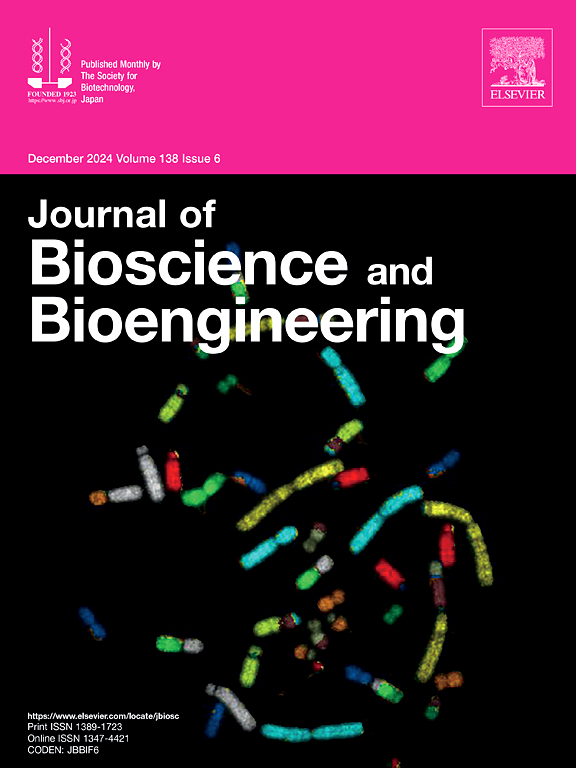Bioconversion of eicosapentaenoic acid into 5S,15S- and 5R,15R-dihydroxyeicosapentaenoic acids by double-dioxygenating 15S- and 15R-lipoxygenases
IF 2.3
4区 生物学
Q3 BIOTECHNOLOGY & APPLIED MICROBIOLOGY
引用次数: 0
Abstract
Resolvin E series (Rvs), such as RvE4 (5S,15S-dihydroxyeicosapentaenoic acid) and its stereoselective enantiomer (5R,15R-dihydroxyeicosapentaenoic acid), play an important role in promoting the resolution of inflammation and are derived from eicosapentaenoic acid (EPA) by M2 macrophage in human. However, they have been synthesized using expensive and inefficient chemical methods. Here, we performed efficient quantitative production of RvE4 and its enantiomer from EPA using Escherichia coli expressing double-dioxygenating 15S-lipoxygenase (15S-LOX) from Archangium violaceum and double-dioxygenating 15R-LOX from Sorangium cellulosum, respectively, with solvent, polymer, and adsorbent resin. The cell density, substrate concentration, solvent types and concentrations, polymer types and concentrations, and resin concentration were optimized for the enhanced bioconversion of EPA into RvE4 and its enantiomer. Under the optimized conditions, A. violaceum 15S-LOX and S. cellulosum 15R-LOX expressed in E. coli converted 6.0 mM EPA into 4.3 mM (1.44 g/L) RvE4 and 5.8 mM (1.94 g/L) RvE4 enantiomer in 60 min, with productivities of 4.3 and 5.8 mM/h and molar conversions of 72% and 97%, respectively. To date, these are the highest concentrations, productivities, and conversions of RvE4 and its enantiomer. The concentrations of RvE4 and its enantiomer obtained from the conversion of EPA with solvent, polymer, and resin were 2.5- and 3.2-fold higher than those without the additives, respectively.

通过 15S- 和 15R- 脂氧合酶将二十碳五烯酸生物转化为 5S、15S- 和 5R、15R- 二羟基二十碳五烯酸。
Resolvin E 系列(Rvs),如 RvE4(5S,15S-二羟基二十碳五烯酸)及其立体选择性对映体(5R,15R-二羟基二十碳五烯酸),在促进炎症消退方面发挥着重要作用,由人类 M2 巨噬细胞从二十碳五烯酸(EPA)中提取。然而,人们一直使用昂贵而低效的化学方法合成它们。在此,我们利用大肠杆菌分别表达来自Archangium violaceum的双倍二氧化15S-脂氧合酶(15S-LOX)和来自Sorangium cellulosum的双倍二氧化15R-LOX,并使用溶剂、聚合物和吸附树脂,从EPA中高效定量地生产出了RvE4及其对映体。对细胞密度、底物浓度、溶剂类型和浓度、聚合物类型和浓度以及树脂浓度进行了优化,以增强 EPA 向 RvE4 及其对映体的生物转化。在优化条件下,在大肠杆菌中表达的 A. violaceum 15S-LOX 和 S. cellulosum 15R-LOX 在 60 分钟内将 6.0 mM EPA 转化为 4.3 mM(1.44 g/L)RvE4 和 5.8 mM(1.94 g/L)RvE4 对映体,生产率分别为 4.3 mM/h 和 5.8 mM/h,摩尔转化率分别为 72% 和 97%。这是迄今为止 RvE4 及其对映体的最高浓度、生产率和转化率。在 EPA 与溶剂、聚合物和树脂的转化过程中获得的 RvE4 及其对映体的浓度分别是未添加添加剂时的 2.5 倍和 3.2 倍。
本文章由计算机程序翻译,如有差异,请以英文原文为准。
求助全文
约1分钟内获得全文
求助全文
来源期刊

Journal of bioscience and bioengineering
生物-生物工程与应用微生物
CiteScore
5.90
自引率
3.60%
发文量
144
审稿时长
51 days
期刊介绍:
The Journal of Bioscience and Bioengineering is a research journal publishing original full-length research papers, reviews, and Letters to the Editor. The Journal is devoted to the advancement and dissemination of knowledge concerning fermentation technology, biochemical engineering, food technology and microbiology.
 求助内容:
求助内容: 应助结果提醒方式:
应助结果提醒方式:


